Virtual Enterprise and Corporate Memory
Myriam Ribière, Nada Matta
INRIA (projet ACACIA)
2004 route des Lucioles BP. 93
06902 Sophia-Antipolis Cedex
e-mail: {mribiere, nmatta}@sophia.inria.fr
Abstract
In Concurrent Engineering, several designers in different fields and from
different enterprise collaborate to build a product. This organization
is a temporal organizational structure, called virtual enterprise. In fact,
once the project is realized, the virtual enterprise is dissolved, so the
deal in such organization is to keep the volatile knowledge. In this paper,
we propose a guide to elaborate a corporate memory in Concurrent Engineering
by identifying the type of memory needed, the contents of memory according
to its use during the Concurrent Engineering process.
Keywords
Corporate Memory, Project Memory, Knowledge Management, Viewpoints, Concurrent
Engineering.
I. Introduction
Concurrent Engineering (CE) is a difficult task in which several designers
in different fields collaborate to build a system that satisfy some requirements.
Hence, it is important to facilitate teamwork and collaboration between
participants in the development process. Learning from past cases can be
considered as guidelines to manage problems that occur in CE task, especially
in collaborative decision making. So, the need to build a memory of projects
appears straightforward for this task.
The objective of this paper is to guide in the elaboration of a virtual
enterprise memory by establishing the essential knowledge needed during
the CE task. The CE organization like all virtual enterprise organization
is a temporal organizational structure, where several designers in different
fields and from different enterprise collaborate to build a product. A
virtual enterprise memory is a corporate memory that takes into account
knowledge of those groups of people. This virtual enterprise memory includes
different memory types pertinent for knowledge (know-how) of professions,
collective information, and knowledge resources of a CE project (project
experiences, problem solving expertise, design rationale) [25].
The purpose of this memory is to guide the project realization in reference
to profession knowledge and past CE experiences.
We based this paper on the CE cycle (the associated task model) (Cf.
III) and different typologies of memories proposed in Corporate Memory
(CM) (Cf. III. 2) to define an adapted
typology of memories and the different possible construction of a memory.
Then we analyse (Cf. IV) information
needed during the different tasks and propose also a content description
of a virtual enterprise memory.
II. Corporate Memory
II. 1. Definitions
The objectives of knowledge management in an organization are to promote
knowledge growth, knowledge communication and knowledge preservation in
the organization [28]. According to
Pasahow cited in [19], knowledge management
consists of «creating, maintaining and exploiting knowledge infrastructures
and organizational knowledge cultures and making knowledge pay off».
Knowledge management is a very complex problem and can be tackled from
several viewpoints: socio-organizational, financial and economical, technical,
human, legal [6].
There is an increasing industrial interest in the capitalization of
knowledge (i.e. both theoretical knowledge and practical know-how) of groups
of people in an organization, such groups being possibly dispersed geographically.
In [11] «corporate memory»
is defined as an "explicit, disembodied, persistent representation of knowledge
and information in an organization". It may include knowledge on products,
production processes, clients, marketing strategies, financial results,
plans and strategical goals, etc. Prasad and Plaza, in [19]
define corporate memory as "the collective data and knowledge resources
of a company including project experiences, problem solving expertise,
design rationale, etc" and it may include database, electronic documents,
reports, product requirements, design rationale, etc. It is a "repository
of knowledge and know-how of a set of individuals working in a particular
firm" [7] and its building relies on
the "will to preserve, in order to reuse them later or the most rapidly,
reasonings, behaviours, knowledge even in their contradictions and with
all their variety" [22]. Knowledge capitalization
is the process which allows to reuse, in a relevant way, the knowledge,
of a given domain, previously stored and modelled, in order to perform
new tasks [26]. The purpose is to "locate
and make visible the enterprise knowledge, be able to keep it, access it
and actualize it, know how to diffuse it and better use it, put them in
synergy and valorize them" [10].
Several kinds of knowledge can be found in a company: explicit or tacit
knowledge [20]. In many operations of
knowledge capitalization, it is important to identify crucial knowledge
to be capitalized [10]. It has an influence
on the kind of corporate memory needed by the enterprise.
Other definitions of a corporate memory can be found in [6].
II. 2. Corporate Memory & Industrials
An enterprise is not only a unit of production of goods or services conform
to the expectations of clients, in the best conditions of cost, deadline
and quality, but it is also a knowledge production unit [10].
The nature of the needed corporate memory and the efforts needed for building
it may depend on the size of the company (cf. wide-sized groups vs small-sized
and medium-sized firms). The motivation can be various:
-
to avoid loss of know-how of a specialist after his retirement or mutation,
-
to exploit the experience acquired from past projects, and to keep some
lessons from past, in order to avoid to reproduce some mistakes,
-
to take into account the corporate memory for the corporate strategy, decisions
and actions,
-
to improve information circulation and communication in the enterprise,
-
to improve learning of employees in the enterprise.
According to those motivations and before building a corporate memory,
several questions must be asked and solved by the enterprise:
-
What types of memory are needed?
-
What kind of knowledge exists in the enterprise and must contribute to
the construction of the corporate memory?
-
What sort of construction must be used?
In this paper we focus on virtual enterprises in the context of CE. In
fact, a virtual enterprise is constituted of several units from different
enterprises and in different fields. All these units work on one project
and collaborate to define a product. Therefore, the life time of a virtual
enterprise is the same as a project.
We propose in the next sections to precise the definition of corporate
memory for CE and to partially answer to previous questions in a CE context.
III. Concurrent Engineering and Corporate Memory
Before describing the definition of a corporate memory in CE, let-us present
the principal characteristics of CE task.
III. 1. The Concurrent Engineering Task
To study knowledge manipulated in CE projects, we base ourselves on a generic
model [17] for the CE task (Figure
1.).
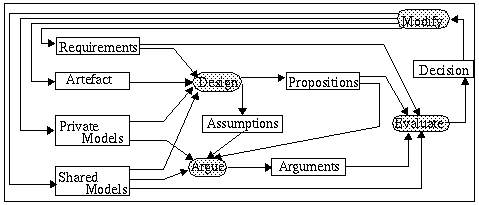 Figure 1. Concurrent Engineering
data flow. Round-corner rectangles are tasks, rectangles are their
input/output.
We distinguish two levels of tasks in this model:
Figure 1. Concurrent Engineering
data flow. Round-corner rectangles are tasks, rectangles are their
input/output.
We distinguish two levels of tasks in this model:
- Individual Design: (Design task),
relying on private knowledge, each designer generates some propositions
to satisfy given requirements.
- Cooperative Evaluation: (Evaluate task), The group evaluates
the integration of propositions in the artefact. Propositions may not satisfy
participants' needs and conflicts can appear. Thus, the principal subtask
in this evaluation consists of detecting and solving conflicts. To promote
the acceptance of his propositions by the group, a participant justifies
them with a number of arguments (Argue task). Assumptions made in
the design task are used to determine arguments and to define them. Argumentation
tries to change other participant's opinion by justifying the utility and
the necessity of a proposition [2].
It forms an important part of negotiation which aims at solving a conflict.
We can remark that different types of knowledge (private and shared) and
different types of tasks (individual and cooperative) are manipulated in
CE task. Note also that several expertise fields are implicated and that
designers may be in geographically distant sites. So, different types of
knowledge (related to profession, to experience, etc.) have to be capitalized
and designers need to access them (from a relative field, or collaborative
decisions,...) for each task.
III. 2. Bases for the Elaboration of a Corporate
Memory in CE
We first present different memory typologies proposed in the CM literature,
and analyse what sort of typology can be used in CE. We also propose to
determine what sort of bases may be built for each memory type and we present
an overview of the different sorts of construction, to help and guide in
the construction of the different bases proposed.
III. 2. 1. Typologies of corporate memories
The corporate memory types take into account the diversity of knowledge
and information found in a firm. There are several typologies in CM literature.
We choose two of them, that are more relevant for our study.
[22] distinguishes:
-
"technical memory". Capitalization of employees' know-how
-
"organizational memory". Past and present organizational
structures of the enterprise
-
"project memories". Capitalization of lessons and experiences
from given projects
[30] proposes different types and their
content:
-
"profession memory". Referential documents, tools and methods
used in a profession
-
"society memory". Organization, activities, products, participants
(customers, suppliers, sub-contractors)
-
"individual memory". Status, competencies, know-how, activities
of a given member
-
"project memory". Project definition, activities, history
and results
In those typologies, we can see that there is a distinction between information
and knowledge considered as references (sort of persistent objects that
everyone can use) and information and knowledge relative to an experience,
only usable if a new experience is similar to one of the experience referred
in the CM. Nevertheless, there is no "society memory" in CE. A project
is performed by a number of designers belonging to different enterprises.
This organization differs from a project to another. So, an organization
memory in CE is related to a project.
Considering these characteristics, we define the following typology
dedicated to CE:
-
"profession memory". Capitalization of participants's know-how
in a profession, Referential documents, tools and methods used in a profession.
-
"project memories":
-
"project definition memory". Definition, organization,
activities, results of projects.
-
"project design-rationale memory". Rationale in the
CE task: history of propositions, problems, solving methods and solutions.
III. 2. 2. Guide for the construction of a virtual enterprise memory
The construction of a corporate memory requires abilities to manage disparate
know-how and heterogeneous viewpoints, to make this knowledge accessible
to the adequate members of the enterprise, to integrate and store this
knowledge in written or electronic documents, or in knowledge bases, or
in case bases, which should be easily accessible, usable and maintainable.
Such a corporate memory should help to support the integration of resources
and know-how in the enterprise and the cooperation by effective communication
and active documentation [6].
The techniques adopted to build a corporate memory depend on the available
sources: specialists, existing written or electronic documents such
as reports or technical documentation, existing database or case libraries,
dictionaries. They also depend on the memory type according to the
intended users. It may consist of written documents making explicit the
enterprise adequate members' knowledge, that had never been yet elicited
and modelled, or of a computational memory, such as an intelligent documentary
system [21], a knowledge base, a case-based
system [26], a combination of documents,
knowledge bases and case bases [13],...
About this, Kühn [13] proposes
that a corporate memory can be composed of different sorts of memories.
The ability to manage both knowledge, elements of experience and documents,
is important as well as the ability to offer information retrieval, and
the ability to store and reuse elements of experience.
-
Proposition for the construction of a virtual enterprise memory
In (Figure 2.) we describe the different
possibilities to build each type of memory described in the CE memory typology.
In the case of:
-
"profession memory" type, we can propose three sorts of constructions:
a non-computational base that provides non-formal documents, a knowledge
base that provides formal knowledge, and a document base. A
profession memory can refer to one of those bases (non formal documents,
formal knowledge and document base) or several of them.
-
"project definition memory" type, we propose to use
a case base defining projects.
-
"project design-rationale memory", we can propose
the same bases as "profession memory" type, and also a data-base of information
provided by participants' activities on tools dedicated to design.
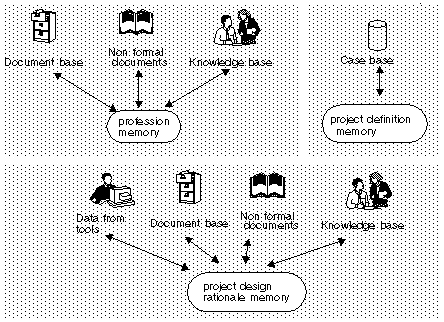 Figure 2. CE typology of
memories and possible associated bases
According to our main objective (a guide to build a virtual enterprise
memory), we present an overview of the different constructions to build
a base corresponding to each type of memory.
Figure 2. CE typology of
memories and possible associated bases
According to our main objective (a guide to build a virtual enterprise
memory), we present an overview of the different constructions to build
a base corresponding to each type of memory.
-
Overview of constructions to help building the different bases
· Non-computational base
A non computational base is composed by (written) documents on knowledge
that had never been elicited previously. The construction of such a base
may be guided by the elaboration of synthesis documents on knowledge that
is not explicit in reports or technical documentation, and is more related
to the know-how of the enterprise through the different experts.
The base is composed of knowledge given by existing documents and interviews
of experts. But the knowledge of the experts is not reduced to what they
can say. The observation of the activity of an expert is another expertise
source for the elaboration of the synthesis document. The KADE-TECH Society
proposes a method called CYGMA [1] to
produce different documents that contain memory about a profession. [26]
considers that this kind of memory provides «a global view of the
knowledge of the firm», and «allows experts from different
sites to describe their knowledge in the same format in order to be able,
afterwards, to compare them more easily». But in [26],
this elaboration of documents synthesis is a first step in the construction
of the knowledge base.
· Document base
A document base relies on the principle that all existing documents of
the firm can constitute the corporate memory. But those documents are not
well-indexed or they constitute a personal bibliography for each expert
of the firm. So, the construction of such a base begins by indexing all
reports, synthesis documents or references used by the different experts,
and requires an interface to manage documents. Poitou in [21]
proposes an intelligent documentary system. He considers that: «a
good documentation system is very likely to be the least expensive and
the most feasible solution to knowledge management». He prefers a
computer assistant to documentation (i.e. to writing or reading) rather
than knowledge representation: according to him, a document is already
a representation of knowledge. So, the main need is assistance in preparing,
storing, retrieving and processing documents. The notion of corporate knowledge
collective management system answers well to this need (examples are given
in SG2C proposed by Poitou and DIADEME proposed by Electricité de
France) [21].
· Knowledge base
Knowledge engineering is naturally useful for building a CM based on elicitation
and explicit modelling of knowledge from experts or even for a formal representation
of knowledge underlying a document. Therefore several researchers that
have been working on expert systems for years evolved towards CM building
where they could exploit their past experiences [6].
However, the goal of a CM building is less ambitious than an expert system:
instead of aiming at an automatic solution for a task (with automatic reasoning
capabilities), a CM rather needs to be an assistant to the user, supplying
him/her with relevant corporate information but leaving him/her the responsibility
of a contextual interpretation and evaluation of this information [13].
Kühn and Abecker [13] notices that
"in contrast to expert systems, the goal of a CM is not the support of
a particular task, but the better exploitation of the essential corporate
resource: knowledge" but, however, cites some knowledge-based CM implemented
through an expert system (e.g. KONUS system aimed at support to crankshaft
design).
Knowledge engineering methods such as COMMET and CommonKADS can be useful
in the construction of a CM, because they allow to analyse and represent
an activity on the knowledge level. Steels [28]
notices that the organization of a production is more and more horizontal,
i.e. the production is organized through activities gathering experts stemming
from different departments. So the CM of such an enterprise can be based
on activity description through three perspectives: task, method and information.
By the same way, even though CommonKADS was not primarily dedicated to
CM building, some models offered by CommonKADS (organization, task, agent,
communication and expertise models) give an interesting basis for knowledge-based
CM [12] and [4].
· Case base
The exploitation of another AI technique, case-based reasoning, can also
be very useful [26]. Indeed each firm
has a collection of past experiences (successes or failures) that can be
represented explicitly in a same representation formalism allowing to compare
them [6]. The use of a case base for
representing the CM is dedicated for the following aims: (1) avoid the
scattering of the expertise by concentrating knowledge of all experts in
dedicated cases, (2) allow a continuous evolution of the CM thanks to the
progressive addition of new cases.
Case-based reasoning allows to reason from experiences and cases already
encountered, in order to solve new problems: e.g. for maintenance of a
complex equipment, the collective memory of past incidents can be useful
for taking a decision in case of a new breakdown. The retrieval of a similar
past case can be used to suggest a solution to a new problem to be solved
(this solution can be reused or adapted if needs be). Improving representation
of the cases, organization and indexing of the case base is important for
enhancing efficiency of case retrieval.
In [26], the author describes an
example in metallurgy, where the aim was to capitalize knowledge and know-how
about descriptions of production of produced steels and metallurgical defects
encountered during these productions. The purpose of the CM was to exploit
past successes and failures in order to minimize error risks in design
of new steels. The method consisted of: (1) creating synthesis documents
common to all sites and respecting a homogeneous format, (2) proposing
models to implement a CM based on such synthesis documents, (3) providing
capitalization processes allowing to use the CM for defects detection purpose.
IV. Contents of each Memory according to each
Task in CE Cycle
We studied above memory types to be considered in the CE task. It is necessary
now, to define precisely the content and the organization of each memory
type related to knowledge needed in each task and their use in the CE cycle.
The main objective of this paper is to show how to define project memory
in CE collaborative decision making. So, we present only this part of memory
in detail (Cf. IV. 2).
IV. 1. Project Memory and Individual Design Task
In this type of task, private knowledge about the field of a designer and
his experiences are needed. In fact, a designer needs to know about conditions
and constraints imposed by objects manipulated in his field, about characteristics
of these objects and about tools and methods to use and under which conditions.
In fact, this knowledge represents the knowledge and know-how of a profession.
So a "profession memory" can keep references to objects manipulated
in a profession and their description, rules on objects, domain laws, methods
and tools used (Figure 3.).
The knowledge engineer needs also to know about past design problems
discovered in his field [31], how they
were avoided or solved, constraints imposed by chosen solutions and how
a solution satisfied given requirements. Experience can be kept as a "Project
definition memory" in which the project context (requirements)
and results (solutions) are defined, and a "Project design-rationale
memory" in which the problem solving expertise is described: encountered
problems, rationale in those problems in term of problem solving methods
used (Figure 3.).
 Figure 3. Information and
knowledge needed during the individual design task
Figure 3. Information and
knowledge needed during the individual design task
IV. 2. Project Memory and Cooperative Evaluation
Task
In cooperative evaluation, propositions made by designers are evaluated
in order to determine if they can be integrated in a single artefact. This
evaluation is done by a group of participants formed by persons in charge
of each submitted proposition and other deciders. We study in this paper
how the definition of a corporate memory can be useful to this task.
We have also to deal with the problem of multi-expertise knowledge
representation in some part of the CE memory. This problem is particularly
important in this task, because all participants must collaborate and exchange
information during the task. Shared knowledge must be represented in a
structure that facilitates consultation of participants. We choose the
viewpoint notion and the conceptual graph formalism (that we explain in
the next sub-section) to represent (or index) the different perspectives,
corresponding to the field of each designer, his task in the design process,
and its competencies.
IV. 2. 1. Viewpoint notion and Conceptual graphs
Viewpoint notion is already exploited in software engineering research
and Object Oriented Representation. Viewpoints are used in complex system
where each participant needs to express his/her knowledge depending on
his/her position in the project and his/her own experiences. In Object
Oriented Languages, developers focus their research on accessibility and
dynamism of models constructed with viewpoints. In TROPES [14]
for example a viewpoint is "a perspective of interest, from which an expert
examines the knowledge base". Viewpoints are also mechanisms allowing to
access a subset of information of a common model, according to a given
user and his needs. In conclusion, viewpoints permit an intelligent modelling
and indexation for information retrieval.
But the word "Viewpoint" is a polysemous word, i.e. its definition depends
on the context of use. The definition of TROPES is a general definition
that can take several interpretations in different applications. In CE,
we must introduce a human dimension that corresponds to the different participants
in a design project, and a knowledge dimension corresponding to the experience,
competence and situation of participants. Generally we can say that a viewpoint
is taken by a person according to his/her knowledge, domain of competence
and his/her objective in his/her activity. Finch [8]
speak about vocational viewpoint for a viewpoint used in a particular work
activity.
So in CE, we characterize a viewpoint by three objects: person, domain,
objective. Each object has a definition:
-
person is described by the name of the person, its situation in
the enterprise and its competencies and level of competence for each competencies,
-
domain is described by the name of the domain, and the current activity,
-
objective is described by a focus in the activity on a design object.
We applied this definition in collaborative design and conflict management
between distributed data. We can notice that person, domain, objective
are always (or more often) present in the elaboration of a viewpoint. So
we can constitute a begin of ontology for CE with those objects and define
viewpoints in CE on this ontology. But the description of each object depend
on the application.
Moreover we consider two important parts in a viewpoint, first the
"Objective" constitute the focus, and second "Domain" and "Person"
constitute the different angles of view on a same focus (Figure
4.).
 Figure 4. example for a
description of a network
Figure 4. example for a
description of a network
According to this definition, we can filter information through the
different objects characterizing a viewpoint.
Furthermore we decided to use conceptual graph formalism with the viewpoint
notion to represent knowledge/information needed during the cooperative
evaluation task. The conceptual graph model [27]
is a graphical knowledge representation model, that structures knowledge
in two levels, a terminological levels and an assertion level. The terminological
level contains the "Support" composed by a concept type lattice and an
ordered set of conceptual relations. The assertion level contains graphs
defined with respect to a canon. A canon contains the vocabulary of experts
to build graphs on an expertise. A conceptual graph is a connected, bipartite,
labelled graph. Each graph can be associated to a first order logic formula
(Figure 5.).
 Figure 5. Example of conceptual
graph
The first reason to choice conceptual graph (CG) formalism is the direct
interaction between participants in the CE process and knowledge/information
represented in the memory. CGs are close to natural language thanks to
their representation of knowledge with concepts and relations, and they
have a graphical display form of logic which is more readable than classical
notations. We exploit also arguments of Gerbé, in [9],
about how conceptual graphs "are a response to the specific requirements
involved in the development of corporate knowledge repositories": the possibility
to express knowledge both at the type and instance level, partial knowledge,
category or instance in relationship, and category or instance in MetaModel.
Figure 5. Example of conceptual
graph
The first reason to choice conceptual graph (CG) formalism is the direct
interaction between participants in the CE process and knowledge/information
represented in the memory. CGs are close to natural language thanks to
their representation of knowledge with concepts and relations, and they
have a graphical display form of logic which is more readable than classical
notations. We exploit also arguments of Gerbé, in [9],
about how conceptual graphs "are a response to the specific requirements
involved in the development of corporate knowledge repositories": the possibility
to express knowledge both at the type and instance level, partial knowledge,
category or instance in relationship, and category or instance in MetaModel.
Taking inspiration of research made in object oriented representation,
we proposed in a previous work [23]
an extension of the conceptual graph formalism to integrate viewpoints
in the support and in the building of conceptual graphs. Viewpoints allow
to define the context of use and the origin (name of the expert or group
of experts, speciality, degree of experience,...) of concept types introduced
in a graph. Our aim was to define viewpoints to help knowledge representation
with conceptual graphs for multi-expert knowledge acquisition and also
to have an accessible and evolutive knowledge base of conceptual graphs
through viewpoints. Viewpoints in conceptual graphs offer the advantages
of the conceptual graph formalism and a way to extract and structure knowledge
more effectively.
We detail in the next sections where viewpoints and CGs have to be used
and their usefulness.
IV. 2. 2. Profession Memory
The "profession memory" must contain theoretical knowledge about conflict
management like methods, and typologies [17]
that can guide the group to manage conflicts (Figure
6.).
The access to this type of memory can be facilitated by a knowledge
server like WebCokace [5] or similar
tools. In fact, an index that associates methods to conflict types in WebCokace,
allows to access to a set of generic conflict management methods. Note
also, that we find in this server a typology [16]
that emphasizes objects about which conflict can appear in CE.
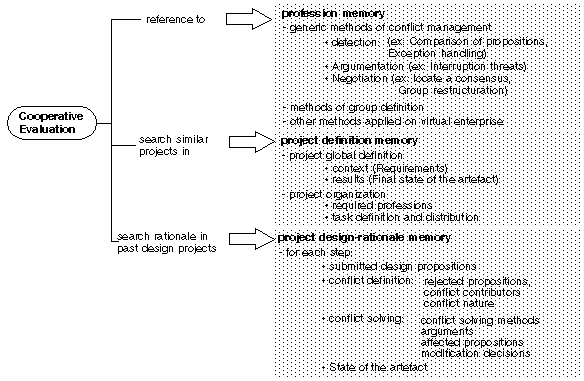 Figure 6. Information and
knowledge needed during the cooperative evaluation task
Figure 6. Information and
knowledge needed during the cooperative evaluation task
IV. 2. 3. Project definition memory
Furthermore, knowledge about past experiences in this type of evaluation
is appreciated. So, informations about how a group can be formed and past
experiences in task distribution and allocation considering different fields,
help an organizer to determine the organization of similar CE projects.
Global information about past projects and their organization can be kept
in a "project definition memory" as (Figure
6.):
-
Project global definition:
The Project global definition contains a project context (Requirements,
basic architecture,...) and the final state of the artefact considered
as the project results. To represent a design object (also called artefact),
Tichkiewitch in [29] proposes a multi-view
product model based on life cycle of the product. Each component of the
artefact must be described under several views by only one expert. The
different views or steps in the life cycle are "skeletal structure or topologic
view", "geometric view", "manufacturing view", "material view", "thermal
view", "mechanical view" and "dynamic/Kinematic view". We can remark according
to our definition of viewpoint, that the couple (object, view) represents
the different focus or objectives, taken by experts to describe objects.
Each expert can also have his description according to the focus. This
model is proposed for only one expert for one view, but we can generalize
and apply it for several experts on one view. Indeed two experts can be
in the same domain, and express their description in the same focus, but
can have two different descriptions that corresponds to their level of
competence and experience in the domain. In the particular case of the
final state of the artefact, the complexity level of viewpoints (several
views and several experts per view) is not really necessary (in this state
the description of the artefact is a consensual description), but the use
of different viewpoints to structure the artefact is useful to make a future
consultation easier when a future project seems to be similar to a project
already stored in the CM. We give an example of the conceptual graph representation
of a part of an artefact state, using viewpoints (Figure
7.).
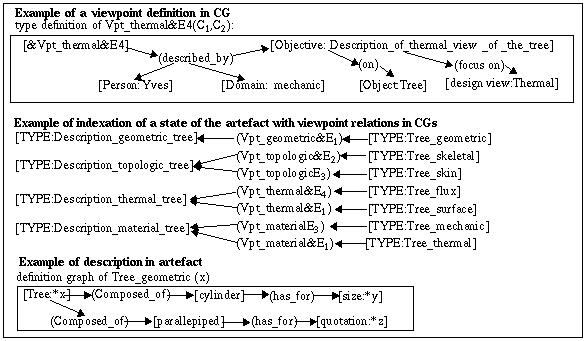 Figure 7. Example of representation
with viewpoints and CGs of a part of an artefact state
Figure 7. Example of representation
with viewpoints and CGs of a part of an artefact state
So, we distinguished four main objects characterising a viewpoint under
which an artefact can be examined: the domain, person, object and design
view. We propose an interface according to this structuring to access easily
to information [24]. This interface
allows to a designer to examine the part of a past product related to his
field. For example, in (Figure 8.) the
object "domain" (characterising a domain viewpoint on the artefact) give
four possibilities to see the artefact: mechanics, electronics, aerodynamics
and hydraulics. The interface, after the selection of the domain, gives
access to the object "objective" characterized in that case by the different
component objects (pump, circuits, brakes) described in the artefact, in
the hydraulic domain.
So, by the selection, through the navigation graph, of the characteristics
of the viewpoint under which the designer wants to see the artefact, we
give access to only information (Conceptual graphs)corresponding to the
need of the designer.
 Figure 8. Example of navigation
through viewpoints: consultation of the hydraulics viewpoint in the artefact.
The project organization memory describes groups implicated in a CE project
and task definition and distribution. So, knowledge in this memory can
be organized around groups, tasks, required professions and persons.
Figure 8. Example of navigation
through viewpoints: consultation of the hydraulics viewpoint in the artefact.
The project organization memory describes groups implicated in a CE project
and task definition and distribution. So, knowledge in this memory can
be organized around groups, tasks, required professions and persons.
There are relations between these types of knowledge bases. In fact,
a designer want sometimes to know about the organization of a past project
that had satisfied similar requirements than a current one. User wants
also to access to results done by a task and for example by a given group
in a given field or to task performed by such designer.
IV. 2. 4. Project design-rationale memory
Problems appearing in cooperative evaluation type are related to discordance
between different fields engaged in a CE project. It is not obvious to
detect these discrepancies and to determine a solution to these conflicts.
Past experiences of conflict management that describe how conflicts are
detected (propositions made, rejected parts, elements that cause conflicts,
explicitation of the nature of conflicts, etc.) and how a solution is determined
(methods used to negotiate rejected elements of propositions, arguments
made to defend them, modifications made in propositions, in requirements
and/or in the project organization) are useful to define a solution of
a similar problem in the integration of design propositions in a single
artefact. Note also that different states of artefacts designed in past
CE projects must be described to take shape of results of decisions made.
This knowledge are relevant in a project "design-rationale memory"
that describes the different steps of cooperative evaluation. Each step
is defined with (Figure 6.):
-
Submitted design propositions
Propositions are submitted by different experts, in different task, and
for different design objectives. So to index all these propositions that
we need to build the project design rationale, we use viewpoints (with
CGs) and we detail more precisely the content of each object describing
a viewpoint (Cf. IV. 2. 1):
-
Domain (field, assigned task)
-
Person (name, role in the project, competencies)
-
Objectives (objectives of the design, proposed design elements and corresponding
requirements). The design elements can be so represented as elements responding
to certain objectives and requiring certain design situations.
Propositions can be represented with different formalisms (stored in an
URL). We propose to build a base of conceptual graphs that index those
propositions according to the viewpoint described by the objects
person, domain and objectives
(Figure 9.). As a consequence, we can
use the navigation graph presented in the project global definition, to
access to design propositions.
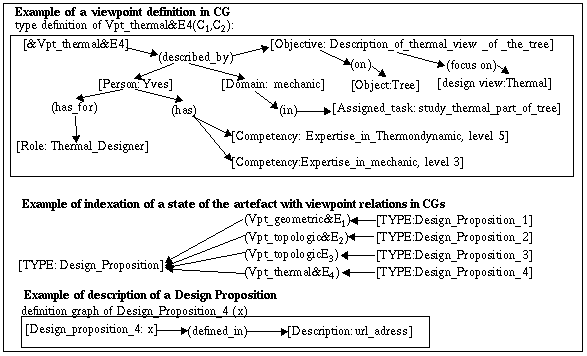 Figure 9. Example of proposition
indexation
A conflict can be described by elements that caused a problem between designers.
These elements bring about the rejection of a number of design propositions.
It is also important to specify the nature of a conflict (responsibilities,
cooperation, etc.). So, to represent a conflict in a memory we recommend
to emphasize:
Figure 9. Example of proposition
indexation
A conflict can be described by elements that caused a problem between designers.
These elements bring about the rejection of a number of design propositions.
It is also important to specify the nature of a conflict (responsibilities,
cooperation, etc.). So, to represent a conflict in a memory we recommend
to emphasize:
-
definition (the nature) of the conflict
-
rejected propositions and persons who rejected them
-
contributors (incoherent elements, objectives of these elements).
This type of knowledge can be organized as:
-
conflict solving methods used (their definition and their results)
-
given arguments,
-
decision made (modifications to done in propositions, requirements, organization
and the process).
A state of the artefact can be represented as same as its final
state described in (Cf. IV. 2. 3) through
person, domain, objects and design view. The representation of each state
of the artefact is important, because it shows the evolution of the project
and the result of decisions taken at each step of the CE process. The use
of viewpoints in the artefact representation allows to always keep the
relation between a knowledge/information element and its origin (person,
design context) and as a consequence permits to give a right understanding
of this knowledge/information element.
Relations between all these types of memories provide different ways
to access to knowledge. For example, given the name of a designer that
rejected a proposition, a user can be informed about his competencies,
his assigned task, his expertise field (retrieved from project organization
memory). He can also ask about past propositions done by the same persons,
about groups with whom he worked, etc. An incoherent element can lead to
the corresponding propositions and even to past propositions, their inter-relations
and the outcome state of artefact, etc.
V. Modelling and Use of the Virtual Enterprise Memory
-
Modelling a part of the memory
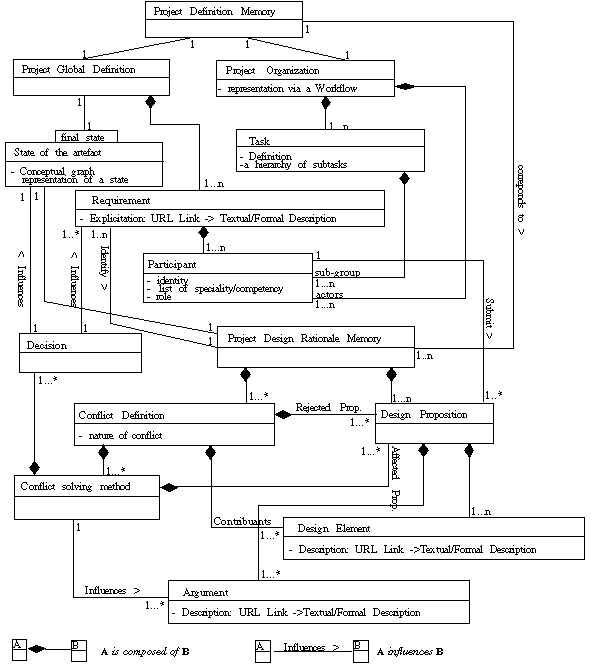 Figure 10. class diagram
of "project definition" and "design-rationale" memories.
As we said above, we study in this paper, memory used in cooperative evaluation.
So, we present in Figure 10. a model
of a part (project memory and design-rationale) of this memory. This model
is defined using UML (Unified Modelling Language) [18].
This provides a representation of relations between the components of such
memory. The "profession memory" is studied in detail in [15].
Figure 10. class diagram
of "project definition" and "design-rationale" memories.
As we said above, we study in this paper, memory used in cooperative evaluation.
So, we present in Figure 10. a model
of a part (project memory and design-rationale) of this memory. This model
is defined using UML (Unified Modelling Language) [18].
This provides a representation of relations between the components of such
memory. The "profession memory" is studied in detail in [15].
In our team, we developed a tool (CREoPS2) to support communication
and evaluation of design propositions in CE cycle [3].
This tool provides a good way to update automatically (as a background
process) the "design-rationale" memory with information and knowledge described
in Figure 10.
-
Use the memory in CE task
We define also a number of use cases of the virtual enterprise memory,
responding to needs of designers to learn from past projects. Figure
12. shows the sequence diagram in the case of consultation of past
similar projects.
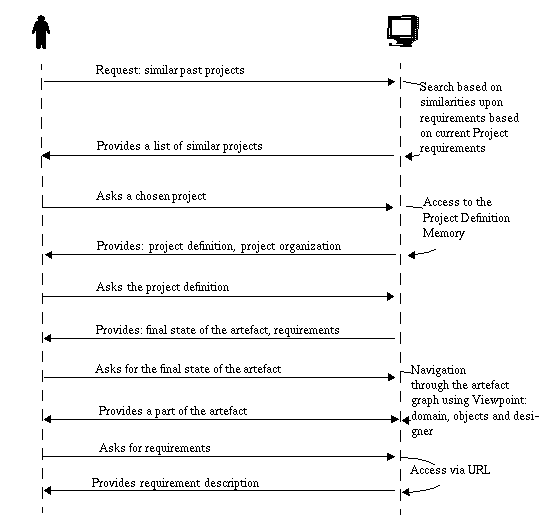 Figure 11. Sequence Diagram
of past similar project consultation.
In cooperative evaluation, the design-rationale memory can be useful to
deal with conflict detected in the current project. So, the Figure
11. presents a sequence diagram of the case of consultation of a design
rationale step of a given project: propositions submitted, conflict detected,
methods used to manage them, etc.
Figure 11. Sequence Diagram
of past similar project consultation.
In cooperative evaluation, the design-rationale memory can be useful to
deal with conflict detected in the current project. So, the Figure
11. presents a sequence diagram of the case of consultation of a design
rationale step of a given project: propositions submitted, conflict detected,
methods used to manage them, etc.
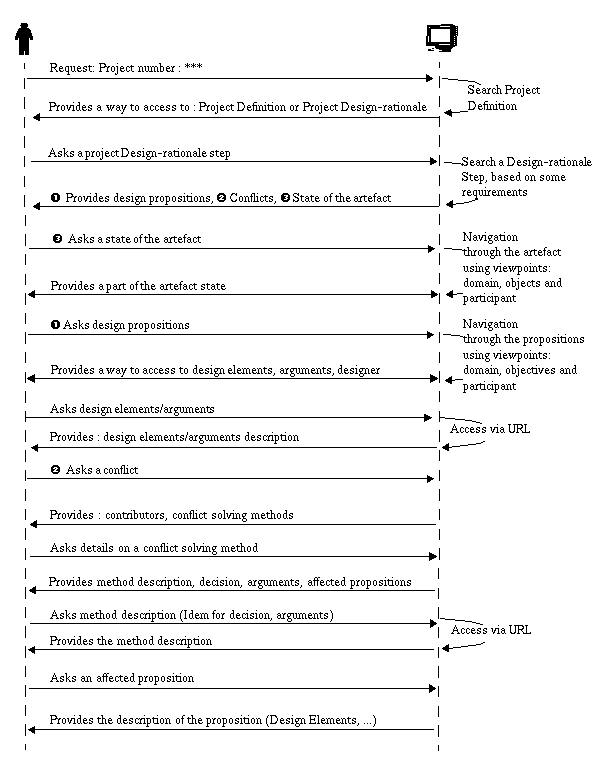 Figure 12. Sequence diagram
of consultation of a design rationale step of a given project.
To sum-up, memories related to a profession and past experiences in a specific
field (profession memory, project definition memory and project rationale
design memory) (Figure 13.) are useful
to a designer. In fact, when a designer has to define individually a proposition
related to a part of the artefact, knowledge described in these memories
guides him in his creativity, judgment and dilemmahandling.
Figure 12. Sequence diagram
of consultation of a design rationale step of a given project.
To sum-up, memories related to a profession and past experiences in a specific
field (profession memory, project definition memory and project rationale
design memory) (Figure 13.) are useful
to a designer. In fact, when a designer has to define individually a proposition
related to a part of the artefact, knowledge described in these memories
guides him in his creativity, judgment and dilemmahandling.
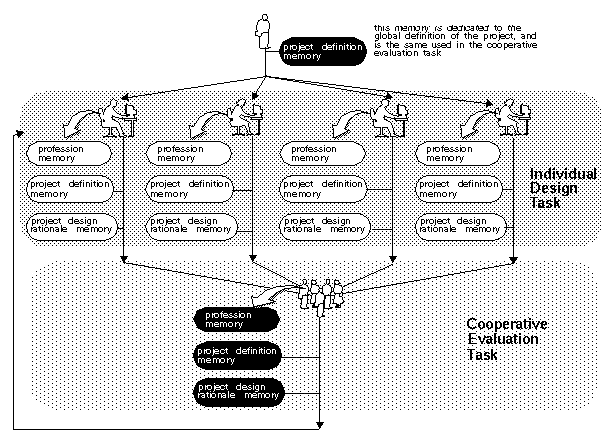 Figure 13. Use of virtual
enterprise memory.
In cooperative evaluation, the problem is to integrate propositions made
by several designers in different fields in a single artefact. So, memories
related to cooperative evaluation tasks that contains generic methods (profession
memory), past organization experiences (project definition memory) and
reasoning statements underlying collaborative decision making (project
design rationale memory) are very appreciated (Figure
13.).
Figure 13. Use of virtual
enterprise memory.
In cooperative evaluation, the problem is to integrate propositions made
by several designers in different fields in a single artefact. So, memories
related to cooperative evaluation tasks that contains generic methods (profession
memory), past organization experiences (project definition memory) and
reasoning statements underlying collaborative decision making (project
design rationale memory) are very appreciated (Figure
13.).
Sub-groups of designers and expertise fields in a CE project must be
first defined. To do that, a manager can examine organizations of similar
past experiences using the project definition memory. This memory can show
also artefacts produced responding to similar requirements than those of
the current project, or of a part of them. A participant can also, recognize
designers that defined such artefacts, their fields and their competencies.
The "design-rationale memory" helps the group of designers in the collaborative
decision making. Lessons learned from past propositions, conflicts appeared
and negotiation done in similar experiences are useful to make decisions.
So, given similar requirements, a participant can access to propositions
done in a field, competencies of the designers who proposed them, corresponding
rejected or accepted ones, related elements that caused conflicts and methods
used to solve conflicts. The corresponding state of the artefact viewed
through the related domain shows the result of the solution done, in the
product.
Through these above examples of the project memory information retrieval,
we can remark the several perspectives of access given by the use of viewpoints
in the project memory representation. These several perspectives form an
excellent help to designers in different fields and having different activities
in a particular CE project.
VI. Conclusion
Elaborating a corporate memory is a challenge for every enterprises because
the memory must constitute an enterprise capital. The definition of a corporate
memory is related to the context under which it can be used. In CE, a corporate
memory is a collection of memories keeping tracks of virtual enterprise
projects. So, it is hard to define those memories according to the diversity
of knowledge and information. We propose in this paper guidelines to elaborate
a CE memory through a dedicated typology and an analysis of each memory
contents. We do not give solutions to know how all those information or
knowledge must be extracted, but we help in the identification of important
knowledge or information needed during the CE task. We propose also to
use viewpoints to make consultation easier and enhance the variety of perspectives
(combination of domain, participants and description task objectives) under
which a user can see or consult parts of the memory. Finally the aim of
viewpoints is to give access to information related to the interest of
the memory user, and help him not getting lost in certain parts (described
in the paper) of the virtual enterprise memory. We plan to validate our
proposition in an aircraft application (with Dassault-Aviation).
References
[1] Bourne, C., Catégorisation et formalisation
des connaissances industrielles. In Connaissances et Savoir-faire en entreprise,
ed. Hermes, p. 179-197, 1997.
[2] C. Castelfranchi, Conflict Ontology,
Proceedings of ECAI'96 Workshop on Modelling conflicts in AI, H.J. Muller,
R. Dieng (Eds), Budapest August 1996.
[3] C. Cointe, N. Matta, Multi-Agents System
to Support Decision Making in Concurrent Engineering. In Tools andMethods
for Concurrent Engineering, Manchester, April, 1998.
[4] Corby , O. , and Dieng R., Cokace: a Centaur-based
environment for CommonKADS Conceptual Modelling Language. In W. Wahlster
ed, Proc. of the 12th European Conference on Artificial Intelligence (ECAI'96),
pp. 418-422, John Wiley & Sons, Ltd. Budapest, Hungary, 1996.
[5] O. Corby, R. Dieng, A CommonKADS Expertise
Model Web Server, Proceedings of ISMICK'97, Management of Industrial
and Corporate Knowledge, Compiegne, October, 1997.
[6] R.Dieng, O.Corby, A. Giboin, M.Ribière,
Methods and Tools for Corporate Knowledge Management, to appear
in Proc. of KAW'98, Banff, Canada.
[7] Euzenat, J. (1996) . Corporate memory
through cooperative creation of knowledge bases and hyper-documents.
In B. Gaines, M.Musen eds, Proc of KAW'96, Banff, Canada, November, pp.
36-1 36-18.
[8] I. Finch, Viewpoints - Facilitating Expert
Systems for Multiple Users, In Proceedings of the 4th International
Conference on Database and Expert Systems Applications, DEXA'93, ed. Springer
Verlag, 1993.
[9] Gerbé, O., Conceptual Graphs for corporate
Knowledge Repositories, In Proceedings of ICCS'97, ed. Springer-Verlag,
Seattle, Washington, USA, August 1997
[10] Grunstein, M. and Barthès J.-P. (1996).
An Industrial View of the Process of Capitalizing Knowledge, In
J. F. Schreinemakersed, Knowledge Management: Organization, Competence
and Methodology, Proc. of the 4th Int. Symposium on the Managementof Industrial
and Corporate Knowledge (ISMICK'96), Rotterdam,the Netherlands, Ergon,
October, p. 265-285.
[11] Van Heijst, G, Van der Spek, R., and Kruizinga,
E. Organizing Corporate Memories, Proc. of KAW'96, Banff, Canada,
November 1996 , p. 42-1 42-17.
[12] Kingston, J. K. C, Modelling Business
Processes using the Soft Systems Approach. In J. P. Barthès
ed., Proc. of the 2nd Int. Symposium on the Management of Industrial and
Corporate Knowledge (ISMICK'94), Compiègne, October 1994, pp. 149-159,
1994.
[13] Kühn O., Abecker A., Corporate Memories
for Knowledge Management in Industrial Practice: Prospects and Challenges.
Journal of Universal Computer Science, 3(8), p. 929-954, 1997.
[14] Mariño O., Rechenmann F., Uvietta
P., Multiple perspectives and classificationmechanism in Object-oriented
Representation, Proceedings of 9th ECAI, Stockholm (SE), pp425-430
(PitmanPublishing, London (GB)), (8-10 août) 1990.
[15] N. Matta, C. Ros, O. Corby. A Generic library
to guide decision making in concurrent engineering,Proc. of Tools andMethods
for Concurrent Engineering, Manchester, April, 1998.
[16] N. Matta, Conflict Management in Concurrent
Engineering: Modelling Guides, Proceedings of ECAI'96 Workshop on Modelling
conflicts in AI, H.J. Muller, R. Dieng (Eds), Budapest August 1996.
[17] N. Matta, C.Cointe, Concurrent Engineering
and Conflict Management Guides, Proceedings of ICED, Tampere, August
1997.
[18] P.A. Muler, Modélisation objet
avec UML, Eyrolles (Ed.), April 1997.
[19] Nagendra Prasad, M.V. N., Plaza, E., Corporate
Memories as Distributed Case Libraries, Proc. of KAW'96, Banff,Alberta,
Canada, November 9-14, p. 40-1 40-19, 1996. Also in http://ksi.cpsc.ucalgary.ca/KAW/KAW96/KAW96Proc.html
[20] Nonaka, I. (1991). The knowledge-creating
company. Harvard Business Review. Nov-Dec., pp. 96-104.
[21] Poitou, J.P. , Documentation is Knowledge:
An Anthropological Approach to Corporate Knowledge Management. Proc.
of ISMICK'95, Compiègne, France, 1995, p. 91-103.
[22] Pomian, F. Mémoire d'entreprise,
techniques et outils de la gestion du savoir. Ed Sapientia.
[23] Ribière, M., Dieng, R., Introduction
of viewpoints in Conceptual Graph Formalism, In Proceedings of ICCS'97,
Ed. Springer-Verlag, Seattle, USA, Août 1997.
[24] Ribière M., Matta N., Cointe C.,
A proposition for managing project memory in concurrent engineering,
In proceedings International Conference on Computational Intelligence and
Multimedia Applications (ICCIMA'98), Churchill, Australia, February 1998.
[25] Ribière M. Matta N., Guide for
the elaboration of a Corporate Memory in CE, To appear in Proceedings
of the 5th European Concurrent Engineering Conference (ECEC'98), Erlangen-Nuremberg,
Germany, April 26-29, 1998.
[26] Simon, G., Knowledge Acquisition and
modeling for Corporate memory:lessons learnt from experience. Proceedings
of KAW'96, Banff, Canada, November 1996, p. 41-1 41-18.
[27] Sowa, J.F., Conceptual Structures, Information
Processing in Mind and Machine. Reading, Addison-Wesley, 1984.
[28] Steels, L, Corporate knowledge management.
Proceedings of ISMICK'93, Compiègne, France, pp. 9-30, 1993.
[29] S.Tichkiewitch, Un modèle multi-vues
pour la conception integrée, in Summer Scool on Entreprises
communicantes: Tendances et Enjeux, Modane, France, 1997.
[30] Tourtier, P.-A. Analyse préliminaire
des métiers et de leurs interactions. Rapport intermédiaire,
projet GENIE, INRIA-Dassault-Aviation, 1995.
[31] K. Wallace, J. Matheson, C. Hogue, D. Isgrove,
Three Years of Running an Integrated Design Project at Cambridge,
Proceedings of ICED, Tampere, August 1997.













